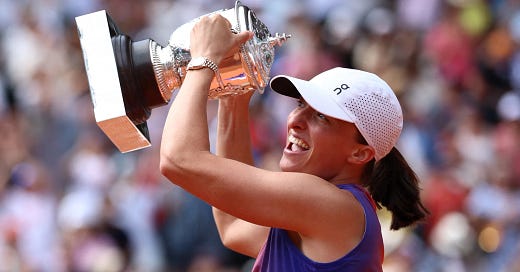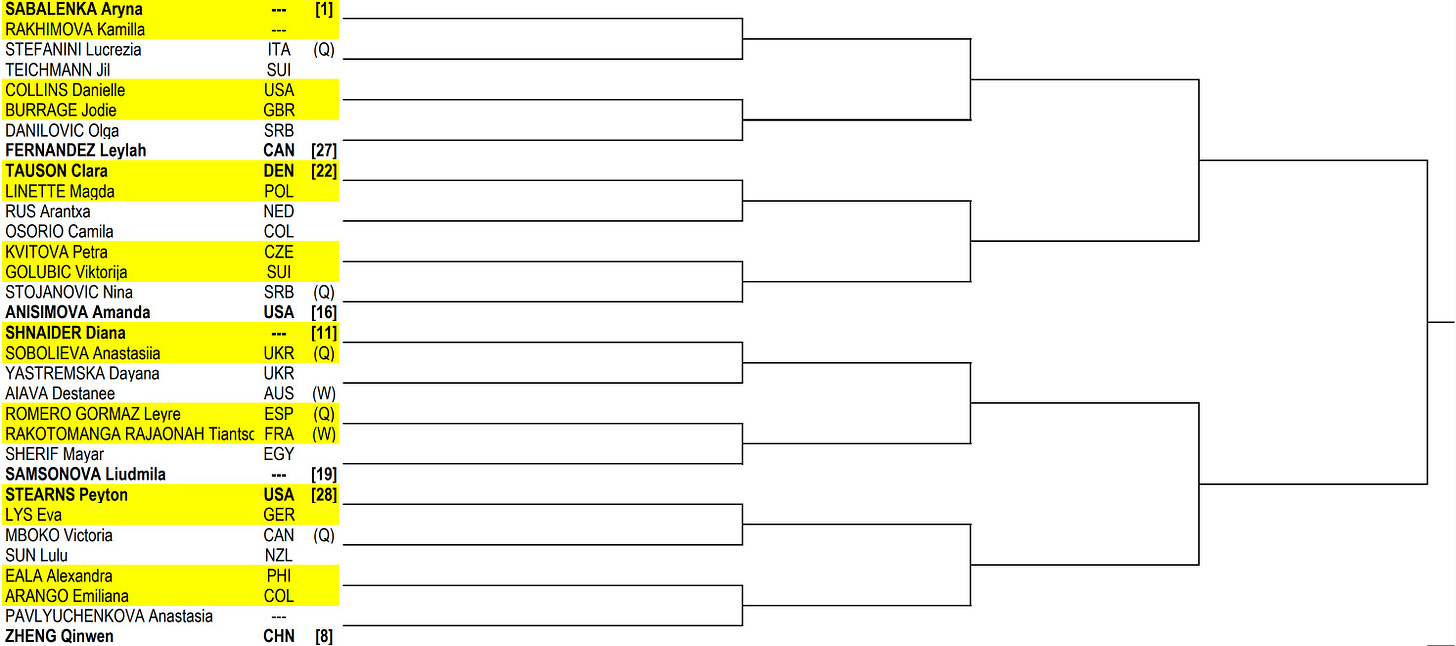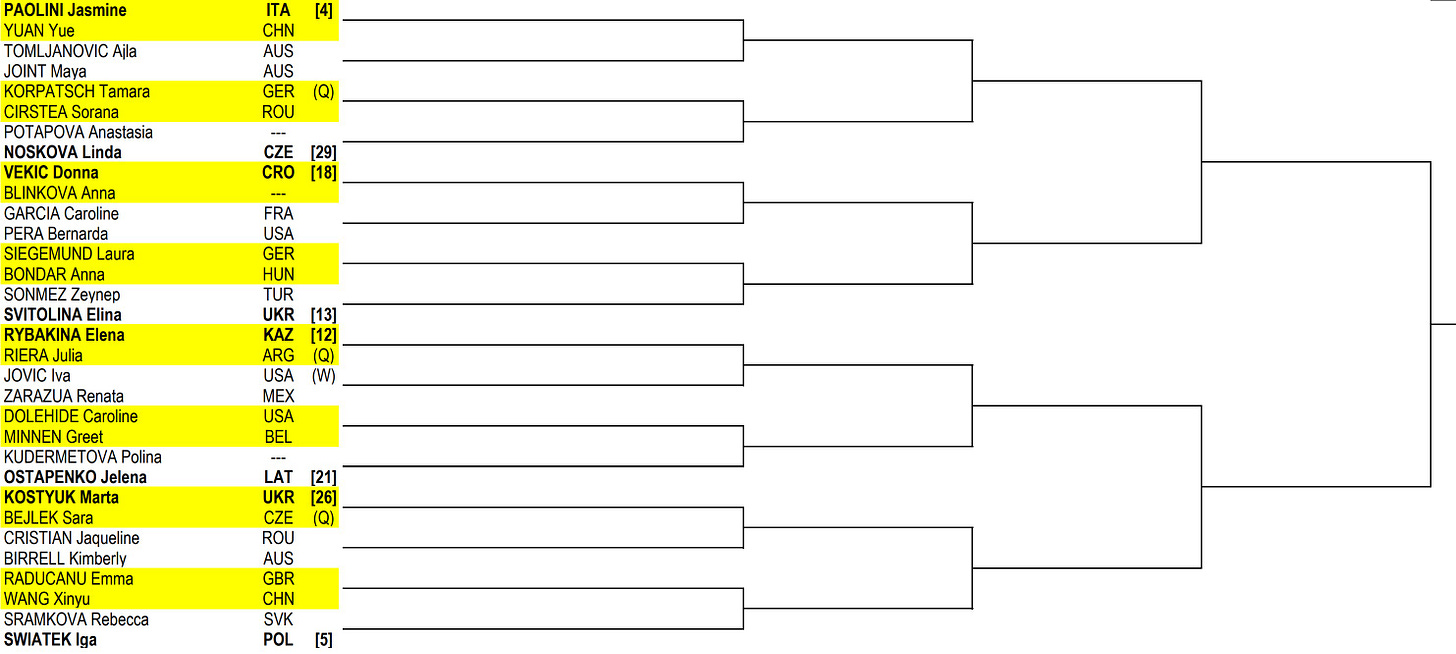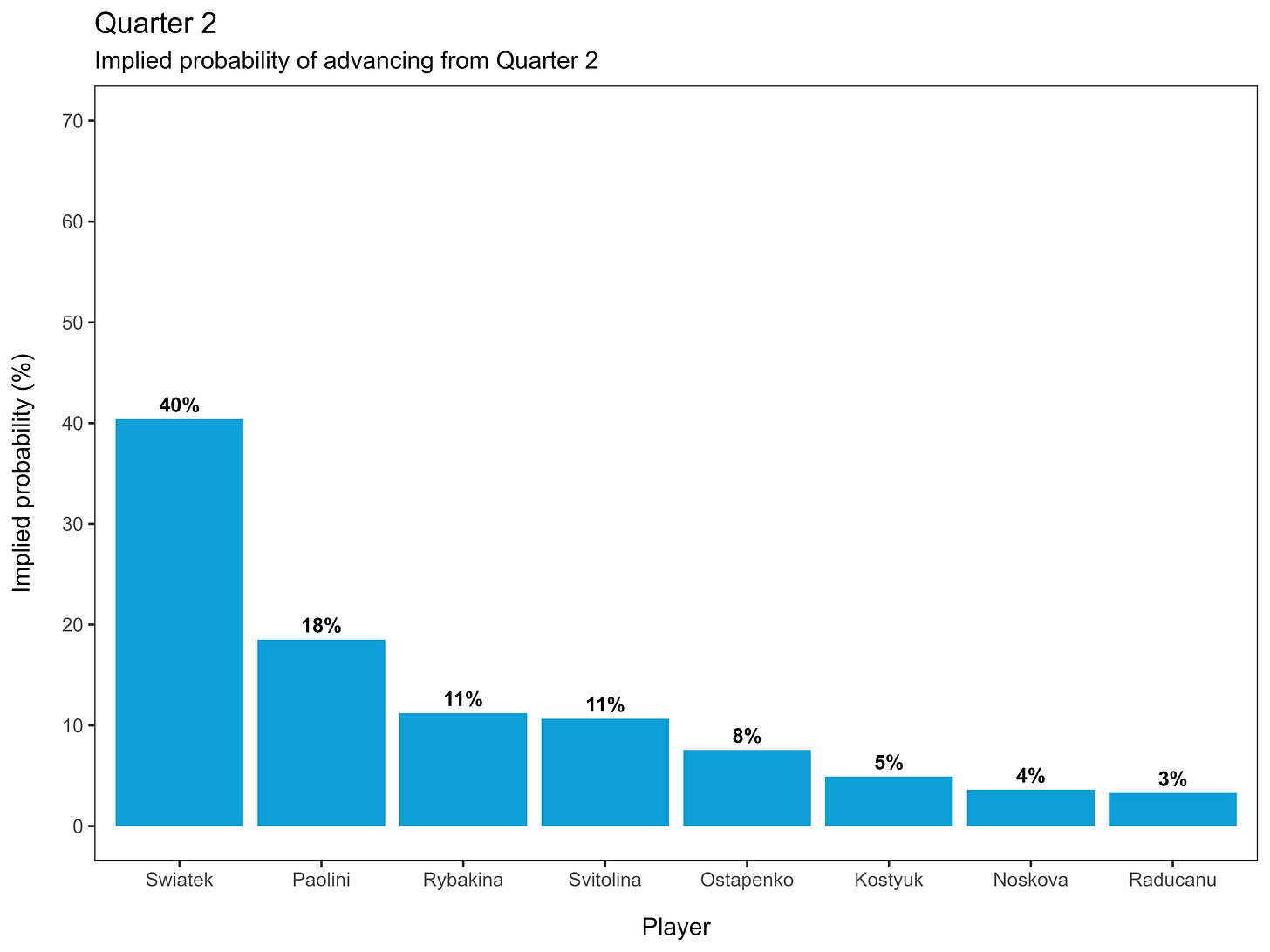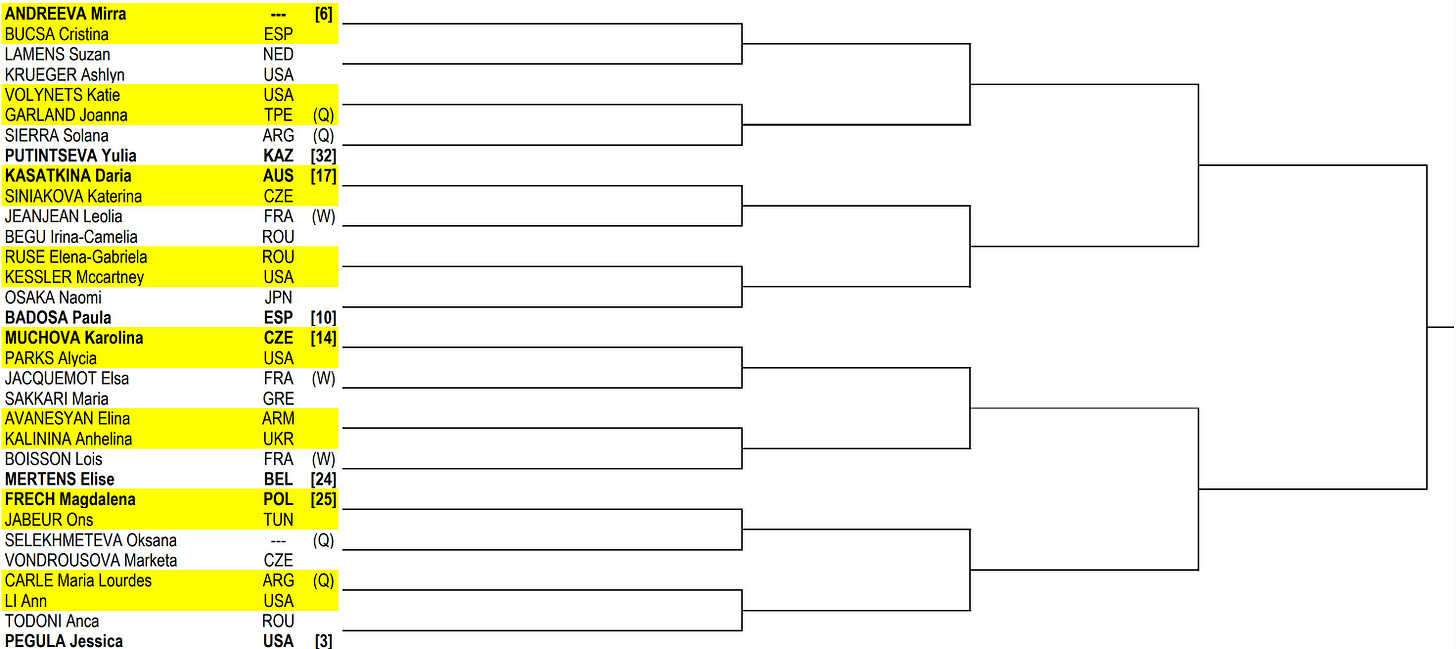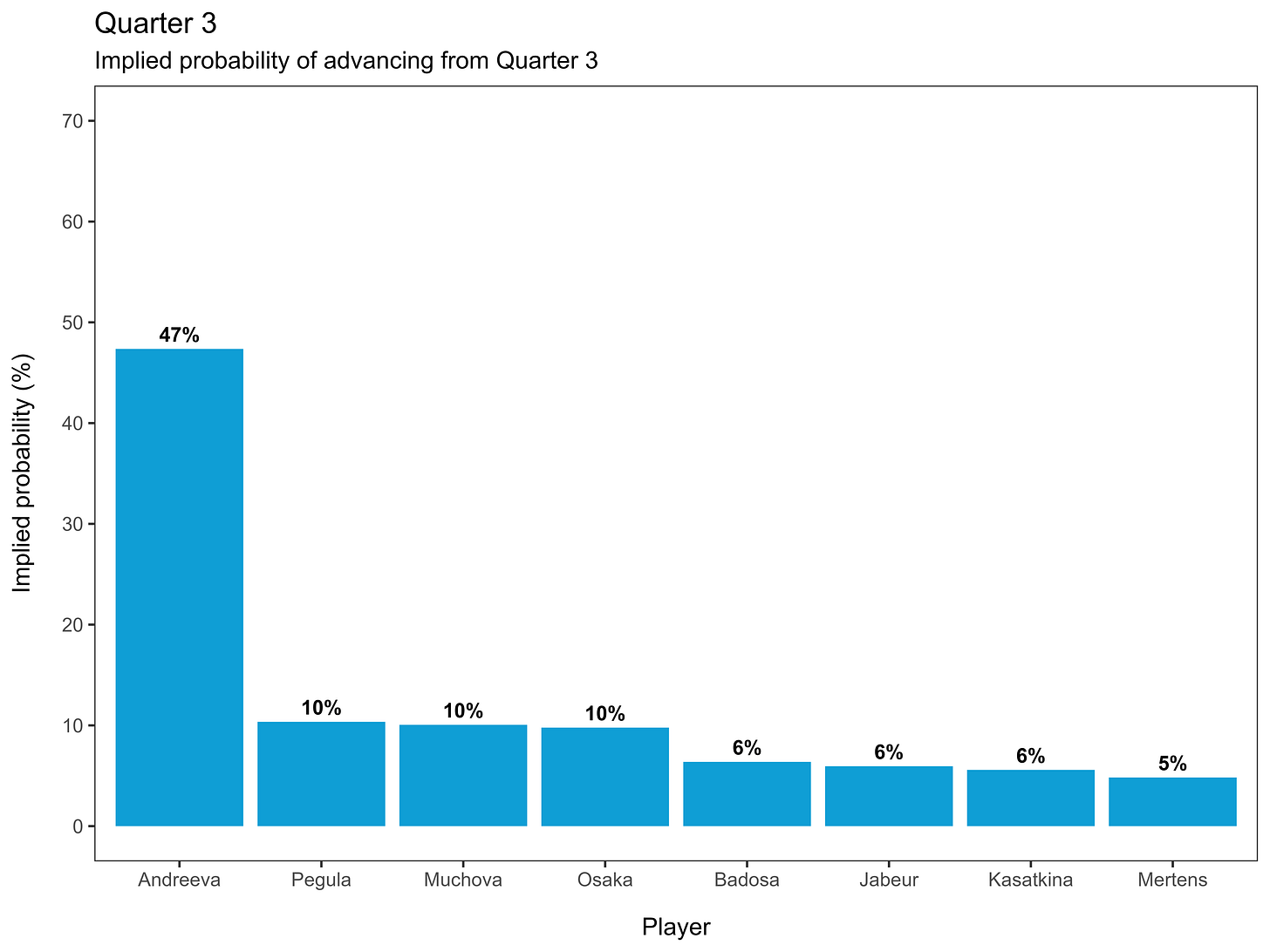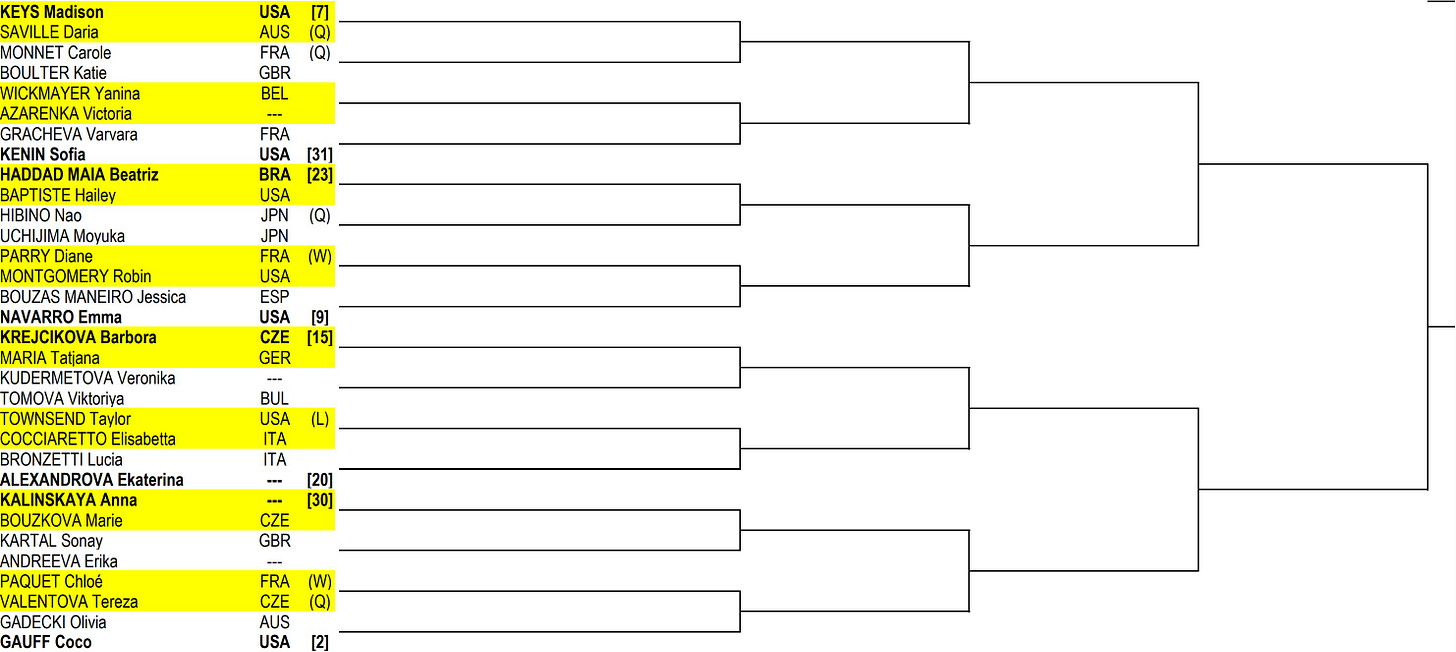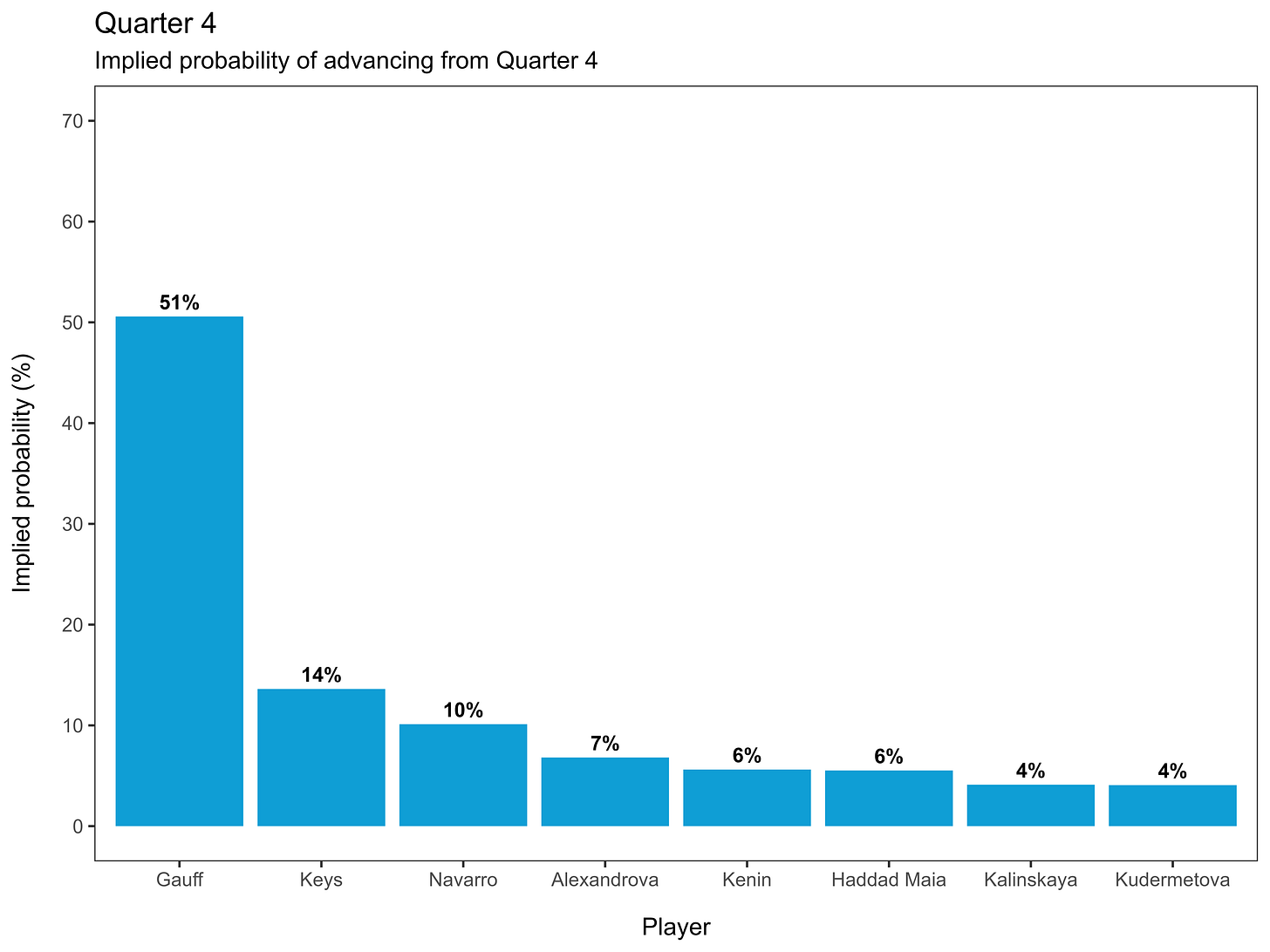Roland Garros Women’s Draw Analysis
Biggest threats, upset chances, players under the radar, implied probabilities
Apologies for the mini-hiatus over the last month – but I’m back with a look at the women’s draw for Roland Garros 2025.
The women’s draw is wide open this year. Swiatek, who has won three consecutive Roland Garros titles, comes into the tournament struggling for form and consistency. Sabalenka and Gauff present as the likeliest challengers to the throne, but there is a swathe of other players who will also fancy themselves on the clay.
As I did in January for the Australian Open draw, I’ll predict who’s most likely to advance from each quarter, who’s most likely to cause an upset, and who’s going under the radar. I’ve also calculated the implied probabilities for players to win their quarter, derived from bookmakers’ odds.1
There’s a poll for each quarter, so you can have your say too!
Quarter 1
According to the bookmakers, Sabalenka is the strong favourite to progress through Quarter 1, with an implied probability of over 50%. Her most likely threat comes in the form of Qinwen Zheng, but Danielle Collins and Amanda Anisimova are capable of serious damage when on form.
Prediction: Sabalenka def. Zheng.
It’s really tough to look past Sabalenka in this quarter. She’s very reliable, and her form has been as solid as ever during this clay season. She lost to Ostapenko in the final of Stuttgart, claimed the title in Madrid, and lost in the quarters to Zheng in Rome. However, she does face a potentially very stern test against Danielle Collins in the third round.
Biggest threat to the favourite: Zheng.
After her recent straight-sets triumph over Sabalenka in Rome, it’s fairly obvious to say that Zheng looms as the obvious threat in this quarter. The biggest question mark for Zheng is whether she can maintain a consistent level of tennis throughout the tournament. She’ll be tested straight away too, with Pavlyuchenkova in the first round, who is a former finalist here at Roland Garros.
Upset chances: Collins.
A potentially mouth-watering third round match up awaits between Collins and Sabalenka. Collins has had a strong lead-up to this year’s Roland Garros – she’s fresh off a big win against Swiatek in Rome, before backing it up with a semi-final berth at Strasbourg. A big hitting duel awaits between these two.
Under-the-radar/potential bolter: Pavlyuchenkova.
It would be easy enough to discount the 33 year-old Russian, but Pavlyuchenkova is a former finalist here at Roland Garros back in 2021. She’s struggled in the lead-up to this year’s tournament, but if Zheng struggles to find her range early, Pavlyuchenkova is more than capable of taking advantage, and could blow her half of the quarter open wide.
Quarter 2
Quarter 2 is the most exciting, and jam-packed quarter of this year’s French Open. There is quality everywhere – Swiatek, Paolini, Rybakina, Svitolina and Ostapenko. Swiatek is the three-time reigning champion, Paolini is fresh off her title at Rome, Rybakina has also just claimed her first title in over a year at Strasbourg. And then there’s Ostapenko, 2017 Roland Garros champion, and Svitolina, who made the Madrid final. So much talent.
Prediction: Swiatek def Paolini.
Despite being severely down on confidence and enduring a run of lacklustre form, I’m backing Swiatek to bounce back at her favourite tournament. She’s got the track record, and although she might have to face Raducanu, Kostyuk and Rybakina/Ostapenko just to make it to the quarters, she’s still the one to beat here at Roland Garros.
Biggest threat to the favourite: Paolini.
Paolini is enjoying her second consecutive stellar clay season, claiming the Rome title for both singles and doubles. In contrast to Swiatek, she’s running on top of the ground, and her half of the quarter is significantly more friendly than Swiatek’s – with Svitolina the biggest threat.
Under-the-radar: Rybakina.
It’s probably not as accurate to label her as under-the-radar following her Strasbourg title, but Rybakina is more than capable of taking control in this quarter if she finds her best form. Her biggest impediment is the draw – it’s likely she’ll have to take down Ostapenko and Swiatek en route to the quarters.
Upset chances: Ostapenko.
It has to be, right? Once again, Ostapenko has found herself in the same quarter with Swiatek. I assume she’s licking her lips at the prospect. Ostapenko went full blitzkrieg to take the Stuttgart title in late April, but has since suffered from her usual inconsistencies – her last loss was against Paolini in Rome, which can be forgiven. She’ll have her eye on a potential fourth round match up against her favourite opponent Swiatek, but she’ll likely have to take down Rybakina on the way. If she gets out of this quarter intact, the rest of the competition is on notice!
Fun match-up: Rybakina/Swiatek/Ostapenko.
If any of these three manage to meet, there’ll be fireworks. A Rybakina-Ostapenko third round match-up looks somewhat likely, and the winner of that will likely take on Swiatek in the fourth round. That’ll be some quality tennis.
Quarter 3
The bookmakers have Mirra Andreeva as the clear favourite to progress from Quarter 3. The 18-year-old, while in strong form this year, will still face a tough task in a quarter packed with some of the tour’s most seasoned competitors, including Pegula, Osaka, Badosa and Muchova.
Prediction: Andreeva def Pegula.
Again, I’m backing in the favourite here. This quarter could throw up a lot of surprises, but many of Andreeva’s biggest threats – like Badosa and Muchova, have been under injury clouds, and clay isn’t Pegula’s preferred surface. Andreeva’s half of the quarter is also very kind – Putintseva might await in the third round, with Osaka/Badosa in the round of 16. Otherwise, a friendly start.
Biggest threat to the favourite: Osaka.
Osaka’s recent run of form coming into Roland Garros has been very solid. She dropped down to a WTA 125 tournament in Saint-Malo to regain some form, which she duly won, before reaching the Round of 16 at Rome. She’s a multiple Grand Slam winner, and while she hasn’t truly recaptured the form of yesteryear, she’s more than capable of taking down anyone in her path.
Under-the-radar: Muchova.
It’s been another disjointed lead-in to Roland Garros for Muchova, who has been struggling with a combination of illness and injury over the last few months. However, she’s got a fantastic all-around game, and a friendly draw to boot – a possible path might be Parks, Sakkari and Mertens to reach the Round of 16, setting up a matchup with Pegula. It’s certainly in reach for a player of her quality.
Upset chances: Pegula.
It’s probably a little counter-intuitive to have the third seed in the tournament here, but Pegula isn’t all that fancied by the bookmakers, despite having reached the quarterfinals here in 2022. Her draw isn’t too brutal, and her best asset is her relentless consistency. Count her out at your own peril. Honourable mention: Badosa.
Quarter 4
In similar fashion to quarters 1 and 3, there is a clear favourite to claim the final quarter – Coco Gauff. Her compatriots, Madison Keys and Emma Navarro, lurk as the biggest threats in this quarter.
Prediction: Gauff def Keys.
Gauff seems the clear favourite in this quarter. Her form is head-and-shoulders above her fellow competitors. She made the final at both Madrid and Rome, and she looks in excellent touch. It was a toss-up between Keys and Navarro – both don’t particularly enjoy the clay, but I’m favouring Keys’ experience here.
Biggest threat to the favourite: Keys.
Keys reached the quarterfinals at Madrid, before losing early on to Stearns in Rome. I’m backing in her experience here – she has plenty of firepower, and although clay isn’t her preferred surface, she’s capable of a lot of damage. A nice run in the first few rounds will help build her confidence too.
Under-the-radar: Krejcikova.
With very, very little tennis under her belt in the last 4-5 months, Krejcikova enters Roland Garros as a bit of an unknown entity. She’s a past champion here, back in 2021, and she’s a genuine threat when she’s in form. But with so little match play since the WTA Finals last year – only 1 match at Strasbourg – it’s hard to know how she will hold up over the course of several matches. Her draw is fairly friendly, and if she can get through a few matches unscathed, anything is possible.
Upset chances: Boulter.
Can Katie Boulter shake things up early in this quarter? She’s fresh off a WTA 125 victory at Paris – her first title on clay. Keys looms in the second round, but if she can get through that, the draw on her half of the quarter opens up. An interesting prospect.
Thanks as always for reading. I’ve got some things I’m working on in the background for Break Point, so stay tuned! I’ll be back with match analysis of the men’s and women’s final over the next fortnight.
A quick note on implied probability:
To estimate the implied probability (percentage chance) of each player winning their respective quarter, the odds of four Australian bookmakers have been used.
Let’s use Iga Swiatek as an example. If, across the three bookmakers, Swiatek is paying an average of $2.00 to win her quarter at the French Open (+100 for US), then the implied probability is 1/2 = 0.5; and then 0.5*100 = 50%. Therefore, Swiatek has an implied 50% probability of winning her quarter, according to the bookmakers’ odds.
However, bookmakers build in a profit margin into their odds. This means that for each quarter, the sum of all implied probabilities (the percentages) will be greater than 100%. To correct for this, I use a scaling factor to adjust the probabilities so they sum to 100%. I limit the scaling factor to the sum of the top 8 players in each quarter (i.e., the 8 players with the best odds of winning the quarter).
For example, if the sum of the implied probabilities across the top 8 players in Swiatek’s quarter is 110%, then I scale the existing probabilities down by a factor of 0.91 (as 100/110 = ~0.91). So, if Swiatek’s implied probability of winning her French Open quarter is 50% before scaling, then it becomes 50*0.91 = 45.5% after adjustment.

